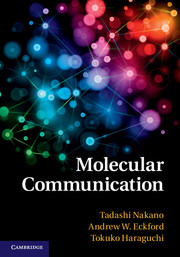Book contents
- Frontmatter
- Contents
- Preface
- 1 Introduction
- 2 Nature-made biological nanomachines
- 3 Molecular communication in biological systems
- 4 Molecular communication paradigm
- 5 Mathematical modeling and simulation
- 6 Communication and information theory of molecular communication
- 7 Design and engineering of molecular communication systems
- 8 Application areas of molecular communication
- 9 Conclusion
- Appendix Review of probability theory
- Index
- References
1 - Introduction
Published online by Cambridge University Press: 05 September 2013
- Frontmatter
- Contents
- Preface
- 1 Introduction
- 2 Nature-made biological nanomachines
- 3 Molecular communication in biological systems
- 4 Molecular communication paradigm
- 5 Mathematical modeling and simulation
- 6 Communication and information theory of molecular communication
- 7 Design and engineering of molecular communication systems
- 8 Application areas of molecular communication
- 9 Conclusion
- Appendix Review of probability theory
- Index
- References
Summary
Historically, communications engineers have dealt with electromagnetic forms of communication: in wireline communication, electric fields move currents down a wire; in wireless communication, electromagnetic waves in the radio-frequency spectrum propagate through free space; in fiber-optic communication, electromagnetic radiation in the visible spectrum passes through glass fibers.
However, this book is concerned with an entirely different form of communication: molecular communication, in which messages are carried in patterns of molecules. As we shall see in this book, molecular communication systems come in many forms.
For example, message-bearing molecules may propagate through a liquid medium via simple Brownian motion, or they may be carried by molecular motors; the message may be conveyed in the number and timing of indistinct molecules, or the message may be inscribed directly on the molecule (like DNA); the nanoscale properties of individual molecules may be important, or only their macroscale properties (like concentration).
Molecular communication is literally all around us: it is the primary method of communication among microorganisms, including the cells in the human body. In spite of its importance, only in the past decade has molecular communication been studied in the engineering literature. In writing this book, our goal is to introduce molecular communication to the wider community of communications engineers, and collect all the current knowledge in the field into a single reference for the sake of researchers who want to break into this exciting field.
- Type
- Chapter
- Information
- Molecular Communication , pp. 1 - 20Publisher: Cambridge University PressPrint publication year: 2013
References
- 1
- Cited by

